DT770 Pro (250Ω)
back to Beyerdynamic
back to measurements
home
published: Feb-28-2015, updated: Aug-1-2021
NO SMOOTHING is applied to the shown plots. Most measurement sites have some smoothing applied which ‘irons flat’ sharp peaks and ‘wiggles’. I do not use smoothing because some info about sound quality is lost when plots are smoothed.
Aside from a small correction of the microphone itself also some correction in the lowest frequencies is applied to the plots to compensate for the perceived loss of bass when using headphones. This is described HERE in more detail.
A ‘horizontal‘ frequency response curve on the shown frequency response plots on this website thus indicates a perceived ‘flat’ tonal signature.
ALL measurements are made with a good SEAL on a flatbed measurement rig.
The shape of your head, bone structure, pad size, pad ‘softness, (compliance), hair or no hair and or wearing glasses may (drastically) change the frequency response of some headphones, so… your personal experience may differ substantially from these plots.
Frequency response (tonal balance) is the most sound-determining aspect of headphones. A horizontal line shows audible neutral response in the plots on this website. Deviations in different severities at different frequency bands have an effect on the sound character.
The bigger the deviation the stronger the effect.
Below an aid to help determining the sound character of headphones with relation to the frequency response.

Beyerdynamic DT770 Pro-250Ω
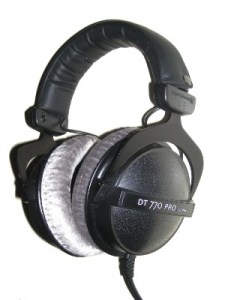 The DT770Pro–250Ω is often seen in studios. It has a quite good attenuation of outside noises, is comfortable and durable. A very sturdy headphone.
The DT770Pro–250Ω is often seen in studios. It has a quite good attenuation of outside noises, is comfortable and durable. A very sturdy headphone.
Like the DT990Pro-250 below this headphone has a long and curled cable with a 3.5mm plug + 6.3mm adapter.
Not suited for on the go, but well suited for on-site recordings etc.
Those looking for a DT770 that can be driven from phones etc. should look for the 32Ω version. The 32Ω version is different sounding because it comes with pleather pads.
There is also an 80Ω version. All these 3 models sound somewhat different as well, it is not just another voicecoil impedance.
Those looking for a DT770 with a straight cable and less clamping force can buy the ‘Edition’ or ‘Manufaktur’ versions. These, again, sound slightly different and look substantially different.
The cable is fixed so not replaceable and coiled. Fully stretched it can reach 3m. The cable is slightly microphonic.
There is a 3.5mm TRS jack with a screw-on 6.3mm adapter. This headphone thus cannot be used on amps with a balanced output.
The pads are comfortable and can easily be replaced. This is needed too as the foam inside tends to decay rather sooner than later.
The headband foam as well is easily replaced and just like the pads available as spare parts.
specifications:
Type: Over ear, closed
Usage: Home, studio
Driver type: dynamic
Pads: replaceable, velours
Collapsible: No
Headphone cup connector: fixed cable
Cable entry: dual entry
Cable: coiled 3m terminated in a 3.5mm TRS jack with a 6.3mm adapter
Driver size: 45mm
Inner pad dimensions: depth: 22mm. diameter: 55mm.
Max. power rating: 0.1W
Max. voltage: 5Vrms (14Vpp)
Max. current: 20mA
Max. S.P.L.: 115 dB
Impedance: 250 Ω
Efficiency: 95dB @ 1mW
Sensitivity: 101dB @ 1V
Weight: 270 g. (excl. cable)
Clamping force: medium (3.5N)
Subjective sound description:
The bass is deep and somewhat (tastefully) elevated. The pad bounce (dip around 90Hz) make the bass quality a bit less and the dip around 220Hz makes the bass ‘disconnected’ from the rest. Mids are good and realistic. The treble is where things get a little sketchy … or should I say ‘etchy’. The elevated treble is fine for monitoring where it adds ‘detail’. For music enjoyment, however, it adds too much sibilance (7kHz) and sharpness (12kHz).
measurements
Below the frequency response of the DT770Pro (Left, Right)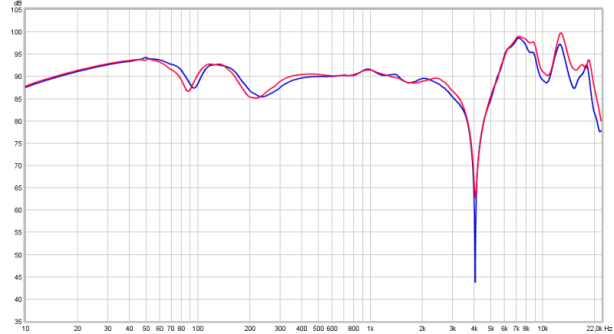
There is something ‘odd’ about this measurement around 4kHz. Here it is rather big and almost completely ‘nulling’. At first I thought it was a typical measuring error as I did not hear the dip while running the sweep. Also when measuring this headphone using white-noise the dip is there but not nulling like in the plot above.
The CSD below provides a clue as to what’s happening.
The deep null is hidden ‘behind’ the wall and when using white noise (or music) the dip isn’t there.

So…. below the ‘corrected’ frequency response as it sounds like and the white noise measurements suggest. It is made from the non-smoothed original measurement where the sharp dip has been ‘replaced’ with a psycho-acoustic smoothing.
This ‘corrected’ plot is shown below and am quite confident it is closer to the truth than the ‘real’ plot.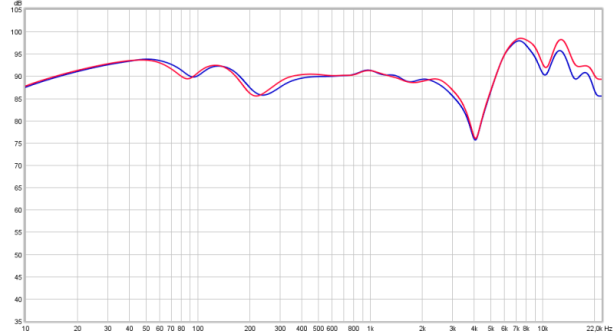 The DT770Pro goes extremely low in frequency response and easily reaches an inaudible 10Hz. The mids are quite decent. The treble is ‘peaky’ and bright. Sibilant on some recordings. It appears highly detailed. The treble also is slightly less ‘smooth’ than the DT990, a bit coarser/rougher.
The DT770Pro goes extremely low in frequency response and easily reaches an inaudible 10Hz. The mids are quite decent. The treble is ‘peaky’ and bright. Sibilant on some recordings. It appears highly detailed. The treble also is slightly less ‘smooth’ than the DT990, a bit coarser/rougher.
It is much less ‘forgiving’ than the DT990 and doesn’t appear to have ‘sucked-out’ mids. The mids aren’t very ‘silky’ but do sound pretty ‘forward’ and dynamic. The bass is another story. Much deeper and more impressive than the DT990 and not as ‘bleeding/warm’ into the mids either. BUT…. the bass isn’t very ‘accurate’ and a bit ‘loose’. This DT770Pro did sound better than the older DT770 I previously owned (as I remember it) as that one had a very ‘one-note’ and ‘resonating’ bass. The Pro version is better in this aspect but sounds somewhat ‘less’ in the upper mids. Still the bass quality isn’t excellent.
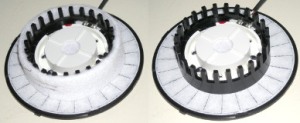 While ‘investigating’ the odd ‘4kHz dip’ I opened the cups and played with wool and damping materials inside, which lowered the amount of bass but the dip remained the same. Only when I removed the felt ‘ring’ around the back of the driver the dip became much smaller and narrower BUT the bass sounded one-note and even more accentuated again.
While ‘investigating’ the odd ‘4kHz dip’ I opened the cups and played with wool and damping materials inside, which lowered the amount of bass but the dip remained the same. Only when I removed the felt ‘ring’ around the back of the driver the dip became much smaller and narrower BUT the bass sounded one-note and even more accentuated again.
Much like how I remember the DT770 sounded that I owned a while ago.
Below the stock DT770Pro (right channel) and with the felt ring removed (see picture above). When filling the cup with wool the bass got lower and better but the dip became deeper and wider again.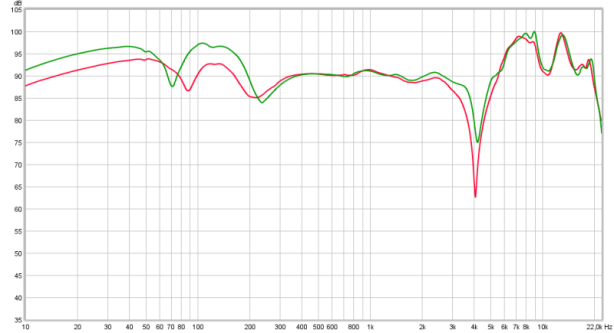
Adding wool when the felt ring was there resulted in slightly more balanced lows but not in a higher quality though.
To remove some of the piercing treble/sibilance I tried 3 mm thick wool felt in front of the driver.
Below the results of the DT770Pro with 3mm thick wool-felt vs stock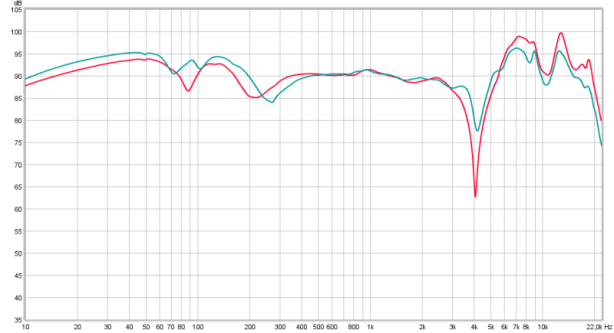 in Replacing the foam disc in front of the driver with a 3mm felt disc (so no hole in the middle) results in slightly elevated bass and somewhat, but not enough, reduction of the treble.
in Replacing the foam disc in front of the driver with a 3mm felt disc (so no hole in the middle) results in slightly elevated bass and somewhat, but not enough, reduction of the treble.
To lower the treble effectively a passive filter (or EQ) is best.
Below the distortion measurement of the DT770.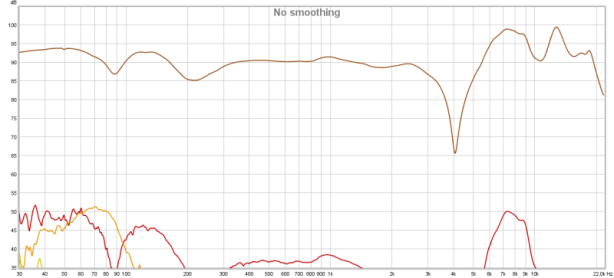
And for those that prefer a percentage scale.
2nd harmonic distortion is low for a 45mm driver but then again with a closed headphone this isn’t as hard as with an open one. The 3rd harmonics around 80Hz are a bit high and point towards very-soft clipping (compression) at these frequencies. The peak at 4kHz is not real but caused by the dip in the frequency response plot. Because of this there appears to be higher distortion there but when looking at the dB scale plot above this one it is obvious the 4kHz peak does not exist.
Below the phase response plot for DT770.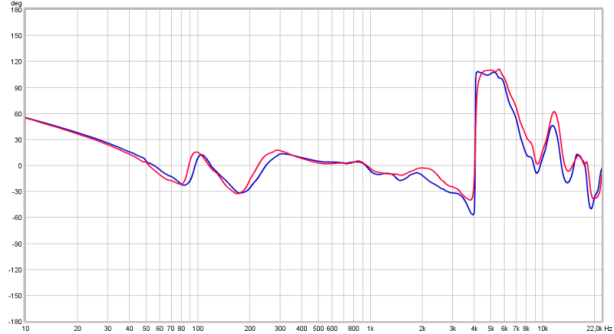
The pad bounce at 90Hz is visible so is the dip around 220Hz. The sharp jump at 4kHz is audible and is caused by the resonance. An almost 180 degrees phase shift is seen in a narrow band.
Below the Group Delay plot for the DT770.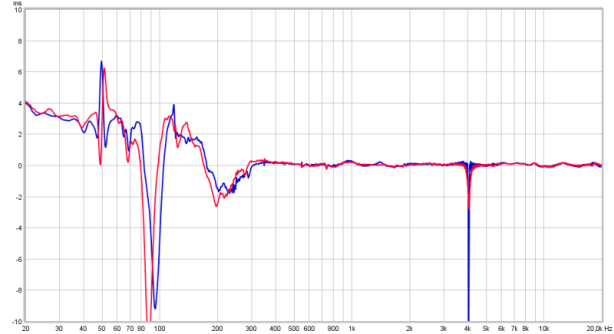
The 50Hz wiggle must be ignored (this is mains frequency leakage). Here too the 90Hz pad bounce and 220Hz issue is shown in this plot. The deep dip at 4kHz is clearly an issue but very narrow band.
treble peak filter
Below the schematic for the DT770-250Ω filter. The filters for the 32Ω, 80Ω and 600Ω versions differ and can be found here.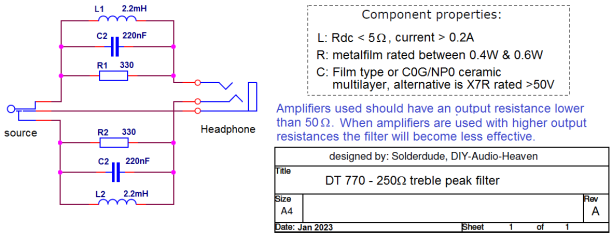
This passive filter goes between the amplifier and headphone cable and removes the sharpness.
conclusion
This headphone is great for monitoring purposes. Especially when having to wear it for longer periods. They are not suited for a final mix nor to apply EQ to individual tracks, monitoring only.
As a Hi-Fi headphone it lacks ‘finesse’ is a bit ‘strange’ in the mids, but not in a bad way. While seemingly having an impressive bass the quality of bass is lacking somewhat when compared to better headphones in this aspect.
It’s high impedance means these headphones need some amplification at least. Those looking for a DT770 that can be driven from phones etc. should look for the 32Ω version. There is also an 80Ω version. These 3 models sound somewhat different as well.
Those looking for a DT770 with a straight cable and less clamping force can buy the ‘Edition’ or ‘Manufaktur’ versions. These, again, sound slightly different and look substantially different.
As far as decent sounding closed headphones is concerned the DT770 is a good choice.
